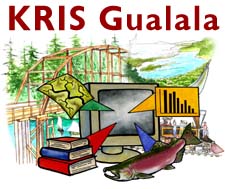Bibliography Background About KRIS
Gualala River Logging History
The scientific record on the Gualala River dates back only to the 1950's but historical photos provide glimpses of the river at an earlier time and pieces of useful information about land management. Logging on the Gualala began in the 1850's and photos document the transition from oxen logging, to use of steam donkeys, to railroad logging and final tractors and trucks. Photos provided courtesy of the Mendocino Historical Society and the Held Poage Memorial Home and Research Library. From the collection of Robert Lee. Click on the images to view at full size.
| This picture shows a typical railroad landing in Gualala Woods about 1902. The big man in the front at left is Chester Byrne, the steam donkey engineer. The combination of mechanized yarding and the railroad increased the speed and efficiency of forest harvest. (#L-3932, Pellacio) | This picture shows a view of the inside of the Westside Gualala Mill Company with a working band saw near the turn of the 20th Century. Note that the log is over eight feet in diameter. Interior photos are rare because of the need for extremely bright lights to use cameras of the day. (#07008-P, MCGS) | The photo above shows the first logging truck in use in the Gualala Woods in 1941 in the Little North Fork Gualala River. This was some of the first use of trucks for logging on the north coast, which became more prevalent after WW II. (#05264, McNamee) |






